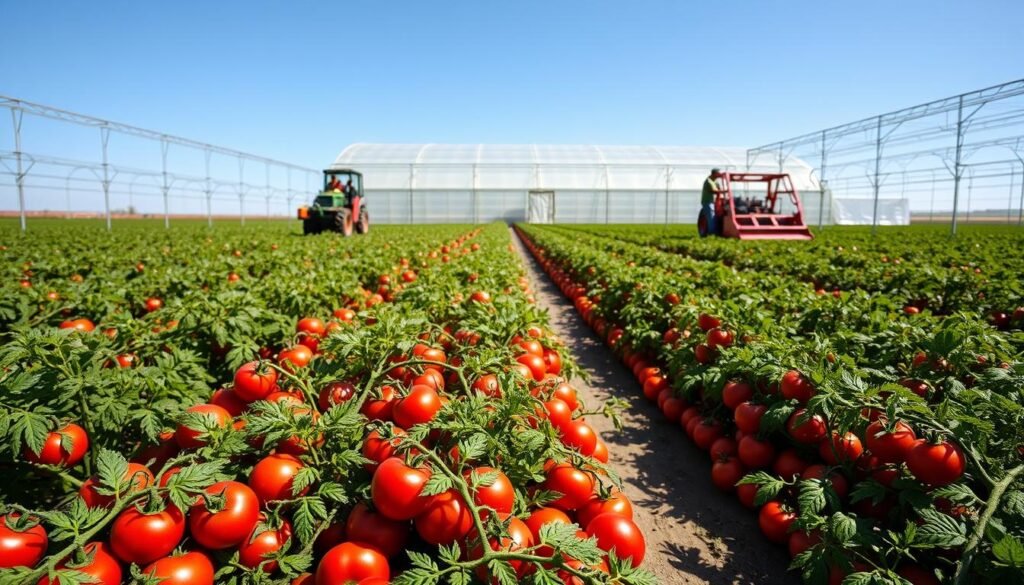In today’s fast-changing world, tomato farming and processing are key to a sustainable food system. The growing global population means more people need fresh, healthy food. Farmers must now grow more while protecting the environment.
To meet these challenges, we need scalable, tech-driven farming methods. These new tools and strategies can make tomato farming more efficient and sustainable. This way, we can feed the world without harming our planet.
So, what are these advanced farming systems, and how do we use them for success? Let’s explore tomato farming and processing together. We’ll uncover the key strategies for thriving in this fast-paced industry.
Key Takeaways
- Understand the current global food production demands and their impact on tomato cultivation
- Explore the role of advanced technologies in enhancing tomato farming efficiency and sustainability
- Discover the essential components of scalable and modern tomato growing systems
- Learn about the latest advancements in disease management and prevention strategies for tomato crops
- Gain insights into the importance of precision farming and post-harvest handling in tomato production
Understanding Modern Tomato Production Challenges
The world’s population is growing fast, and so is the need for food, especially tomatoes. Tomatoes are a key ingredient in many dishes globally. Meeting this demand is tough for farmers and producers. Climate change also makes growing tomatoes harder, affecting quality and sustainability.
Current Global Food Production Demands
The world’s population is expected to hit 9.7 billion by 2050. This puts a lot of pressure on food systems. Tomatoes, being popular, are in high demand. Farmers must find ways to grow more tomatoes sustainably.
Impact of Climate Change on Tomato Cultivation
Climate change has changed tomato farming a lot. Weather like droughts and heatwaves messes up growing seasons. This leads to lower yields and poorer quality tomatoes, making farming harder.
Resource Limitations in Commercial Farming
Commercial tomato farming also faces big challenges. Less land and water are available. Farmers must grow more with less, which is tough. New farming methods and tech are needed to keep farming going.
| Tomato Variety | Days to Harvest |
|---|---|
| Early | Less than 70 days |
| Mid-season | 70 to 80 days |
| Late-season | More than 80 days |
Dealing with these challenges needs a mix of new farming ways, tech, and knowing about the environment. By tackling these issues, we can make tomato farming sustainable. This way, we can meet the demand for tomatoes while dealing with climate change and limited resources.
Essential Components of Advanced Tomato Growing Systems
Cultivating tomatoes has never been more advanced. New systems are changing the game, using the latest tech and data to boost yield and efficiency. Let’s look at what makes these systems so effective.
At the core are hydroponic and greenhouse production methods. These methods let growers control the environment, using resources better and growing better crops. Important parts include climate control, nutrient management, and pest control.
Precision agriculture is key, allowing growers to make smart decisions with real-time data. IoT sensors check soil moisture, temperature, and nutrients. This info helps automate watering, fertilising, and more, saving resources and cutting waste.
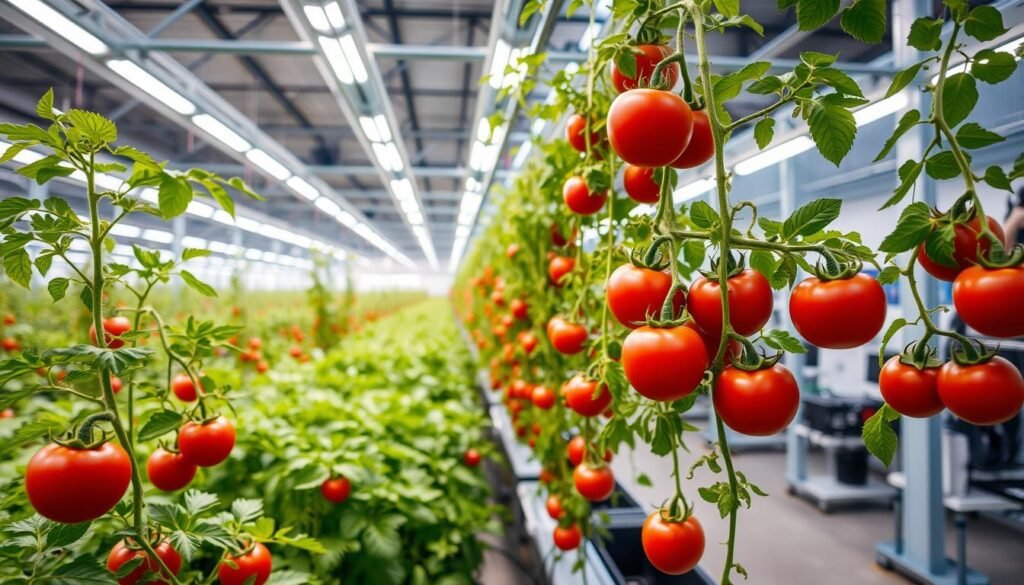
Another vital part is data-driven decision making. Advanced analytics platforms use all this data to help growers improve their methods. This way, they can keep producing top-quality tomatoes that meet today’s market needs.
By using these advanced systems, farming is changing. Today’s tomato farming is all about using data, being efficient, and caring for the environment. It shows the power of innovation and the drive for excellence.
Tomato farming techniques, Commercial tomato cultivation
Tomato farming has become a modern and sustainable practice. It faces challenges like global food demands and climate change. Growers use new methods to get better yields and use resources wisely.
Soil Preparation and Management
Good soil management is key for growing tomatoes. We use no-till farming and crop rotation to keep the soil healthy. Lime is added to adjust the soil pH to 6.0 to 6.8 for better growth.
Preplant fertilizers are mixed into the soil for better nutrient use. This helps the plants grow strong.
Irrigation Systems and Water Management
Using water wisely is important in tomato farming. We use precision irrigation to save water and increase yields. A starter solution with high phosphorus is given to young plants for a nutrient boost.
Plant Spacing and Support Structures
Plant spacing and support are crucial in growing tomatoes. We plant 2,600 to 5,800 plants per acre, with 18 to 30 inches between them. Vertical farming methods like staking and trellising help use land better and make harvesting easier.
By using these tomato farming techniques, we aim to meet the demand for tomatoes. We focus on sustainable soil management, efficient irrigation systems, and the right plant spacing.
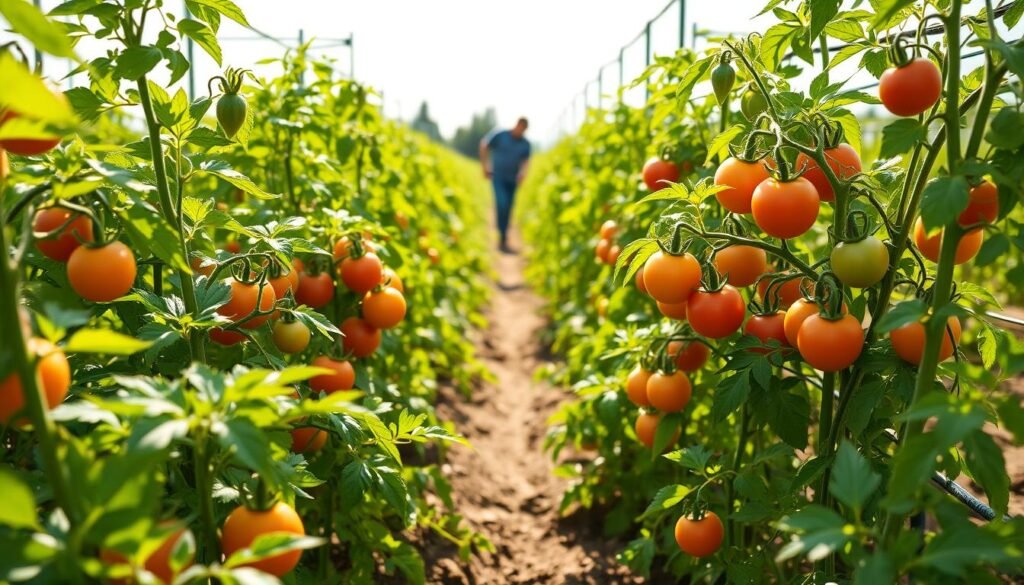
Implementing Smart Agriculture Technologies
The agricultural sector is changing fast, thanks to smart technologies. Organic tomato farming is leading this change with the use of IoT sensors, drones, and AI. These tools are changing how we grow and manage resources.
These technologies give us real-time data on soil health, crop conditions, and more. This information helps us make better decisions and use resources wisely. For example, IoT sensors help us control irrigation systems better, saving water.
But, using these technologies is not easy. It costs a lot and needs training, especially for small farmers. Also, rural areas often lack good internet and standard data protocols.
Still, the benefits are clear. Smart agriculture can make farming more efficient, sustainable, and traceable. It helps us use resources better and predict and prevent pests. These changes could greatly improve organic tomato farming.
| Technology | Application in Organic Tomato Farming | Key Benefits |
|---|---|---|
| IoT Sensors | Monitoring soil moisture, nutrient levels, and environmental conditions | Improved irrigation management, optimised resource utilisation, and enhanced crop health |
| Drones | Aerial imagery and data collection for crop monitoring and precision farming | Early detection of pests and diseases, targeted application of inputs, and reduced labour costs |
| AI-driven Analytics | Predictive modelling, data-driven decision making, and automation of agricultural processes | Increased yields, reduced waste, and enhanced sustainability through precision farming |
Smart agriculture is set to change organic tomato farming for the better. It will make farming more sustainable, efficient, and productive. By tackling the challenges, we can help ensure a food-secure future.
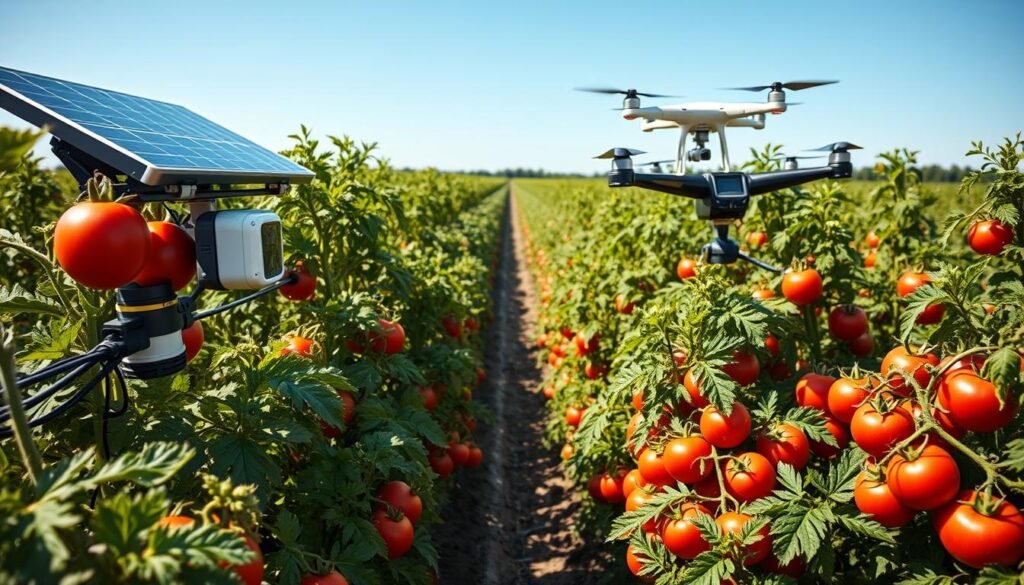
Disease Management and Prevention Strategies
Keeping tomato plants healthy is key for a good harvest. We need to know about common tomato diseases and how to stop them. This helps protect our plants and makes them grow better.
Common Tomato Diseases Recognition
Tomato plants face many diseases like fungal, bacterial, and viral ones. Early blight, late blight, and mosaic virus are big problems. Early blight shows as brown or black spots on leaves and stems. Late blight causes spots that spread fast. Mosaic virus makes leaves look mottled and plants grow slow.
Preventive Measures and Treatment Options
We should act early to fight these diseases. Rotating crops, using disease-resistant tomatoes, and keeping the area clean helps a lot. If diseases do show up, using fungicides or organic sprays can help control them.
Integrated Pest Management Approaches
Integrated pest management (IPM) uses many methods to fight diseases and pests. It includes watching for problems, using cultural controls, and choosing the right biological or chemical treatments. IPM keeps our tomato-growing area healthy and sustainable for the long term.
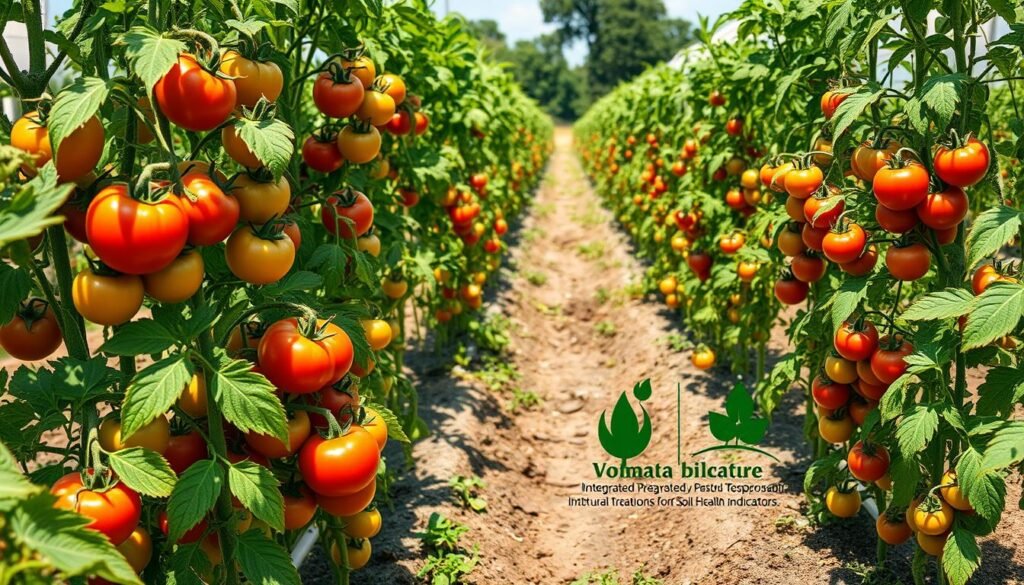
“Proactive disease management is the key to a successful tomato harvest. By understanding the common challenges and implementing tailored solutions, we can protect our crops and maximise our yields.”
Sustainable Greenhouse Production Methods
In modern agriculture, sustainable greenhouses are changing tomato farming. They increase yields and lower environmental impact. This makes them a greener choice. Energy-efficient tech and renewable energy help create productive, eco-friendly greenhouses.
Controlled environment agriculture, or CEA, is key in sustainable greenhouses. It lets us grow tomatoes all year, using resources wisely and cutting waste. Greenhouses use automated climate control, LED lights, and hydroponics. These help grow more tomatoes with less water and pesticides.
Greenhouse tomatoes are profitable, especially in spring and fall. These seasons have fewer tomatoes from fields. But, greenhouses face challenges like humidity, temperature, and pests. Growers must watch these closely all season.
Greenhouses are built with durable materials like steel or aluminum. High walls help with air flow and light for plants. Different covers, like nets and plastic, protect against insects and control light.
Greenhouse farming also uses special climate tools. Fans, misting systems, and shade screens manage the environment. These tools help growers produce more while being kinder to the planet.
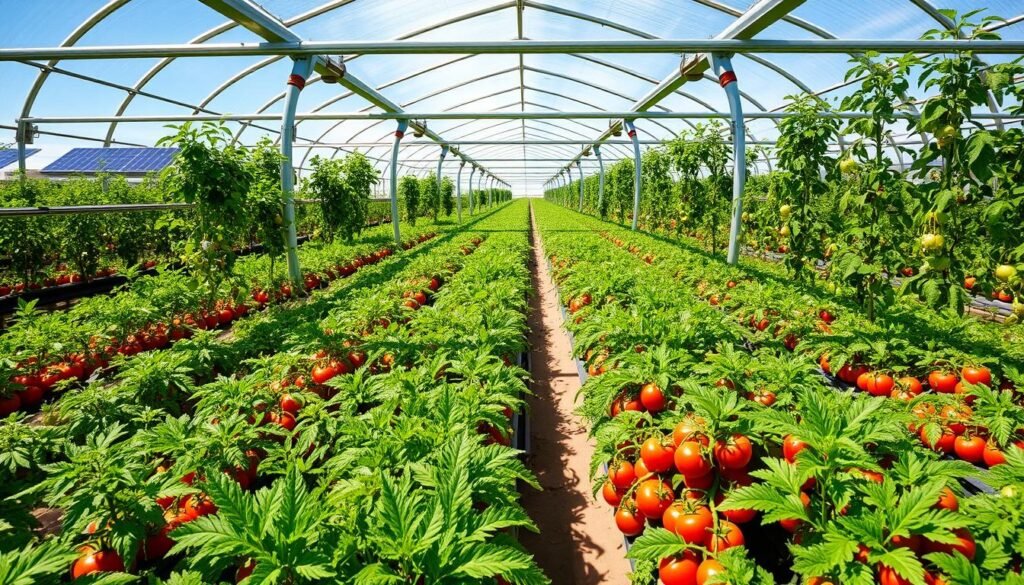
“Sustainable greenhouse production offers a promising solution to meet the growing global demand for high-quality, fresh tomatoes while reducing the strain on natural resources.”
Precision Farming Applications in Tomato Production
Tomato farming is changing with new tech. Precision farming is now used to improve yields and use resources better. Growers use IoT sensors to check soil moisture, nutrient levels, and plant health in real-time. This helps them make better decisions based on data.
IoT Integration in Tomato Farming
IoT technology is changing tomato farming. It gives growers insights to boost productivity. Sensors across the fields collect data. This data helps decide the best times for watering, fertilising, and pest control.
This IoT system helps predict moisture levels. It guides farmers on when to water their tomatoes.
Data-Driven Decision Making
Growers use data from precision farming to make smart choices. The AquaCrop model helps calculate yields and irrigation needs. It’s tailored for different climates and crops.
This approach helps farmers work more efficiently and productively.
Automation Systems Implementation
Precision farming also includes automated systems. In 2017, the 5G RuralFirst project showed how robots and self-driving tractors can plant and harvest. While it costs a lot to start, it saves money and time in the long run.
As farming evolves, precision farming, IoT, and automation will be key. They ensure tomato farming stays sustainable and efficient.
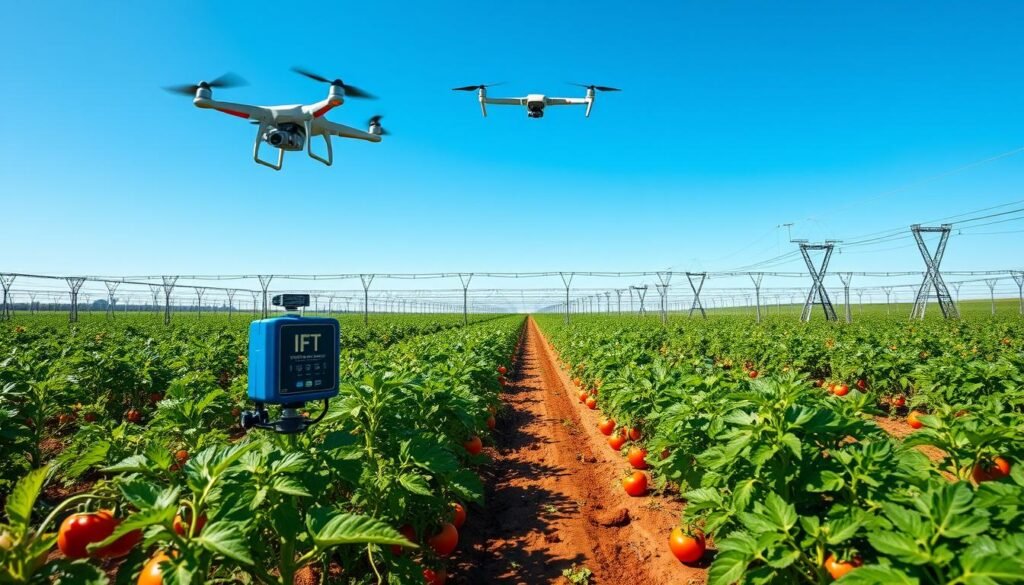
| Key Precision Farming Applications | Potential Benefits |
|---|---|
| Real-time monitoring of soil, plant, and environmental conditions | Optimised resource allocation, improved yield, and reduced waste |
| Data-driven decision making for targeted interventions | Enhanced efficiency, productivity, and profitability |
| Automated systems for tasks like planting and harvesting | Reduced labour costs and improved operational efficiency |
Post-Harvest Handling and Processing
Keeping tomatoes fresh and reducing waste is key. Post-harvest handling and processing are crucial. New sorting and grading tech, using AI, ensures quality stays high. These systems check colour, size, and blemishes, helping pick the best tomatoes.
Processing tech is also getting better, making new tomato products. Think tomato powders, concentrates, special sauces, and canned goods. These innovations help producers offer more and reach more customers. Good cold chain management and packaging keep tomatoes fresh longer, saving their nutrients.
| Tomato Post-Harvest Handling | Tomato Processing Technology | Value-Added Tomato Products |
|---|---|---|
| Machine vision-based sortingAI-powered grading systemsConsistent quality assessment | Tomato powder productionConcentrated tomato productsInnovative sauce manufacturing | Canned tomatoesTomato-based condimentsSpecialty tomato-derived items |
Using the latest tomato post-harvest handling and tomato processing technology opens up new ways to make value-added tomato products. This meets changing consumer tastes and market needs. It’s a smart way to get the most from each tomato harvest, cutting down on waste and boosting profits for everyone.
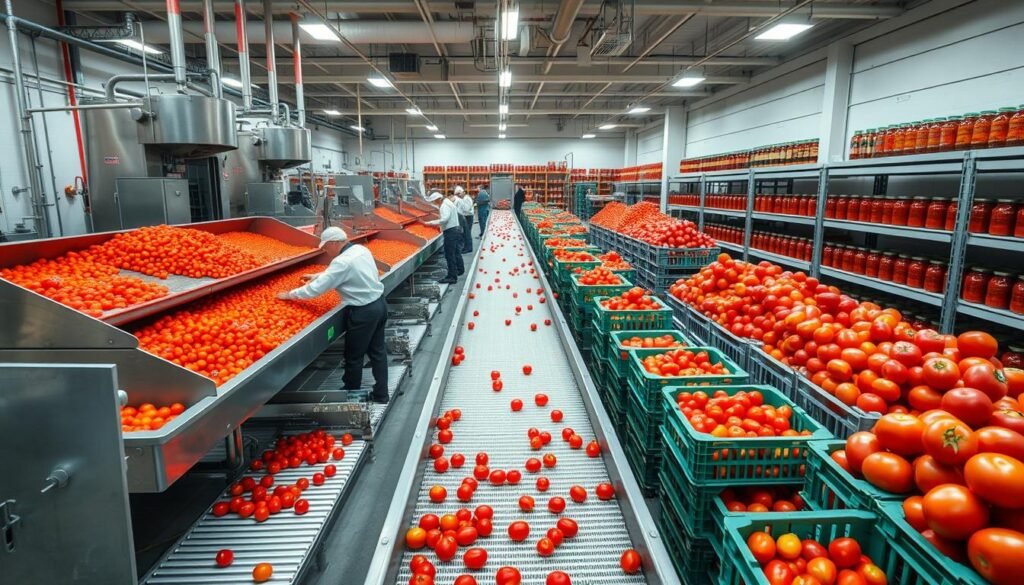
“Preserving the quality and nutritional value of tomatoes is paramount in today’s competitive market. Our innovative solutions are transforming the post-harvest landscape, empowering growers to maximise their yields and diversify their product portfolio.”
Quality Control and Grading Systems
Ensuring top-quality tomatoes is key in today’s farming world. We follow strict international standards like GlobalGAP and BRC. This ensures our tomatoes are safe and of the highest quality.
Our grading tools use advanced technology like spectral imaging and artificial intelligence. They help us sort tomatoes by size, colour, and any defects. This way, we meet our global customers’ high standards.
We also test our tomatoes for pesticides, microbes, and nutrients regularly. This careful testing meets strict export rules and builds trust with our customers. Our quality systems help us provide a top-notch product every time.
Our focus is on maintaining the highest standards in tomato farming and processing. With our modern grading systems and quality checks, every tomato we sell shows our commitment to excellence.
FAQ
What are the current global food production demands and challenges?
The world’s food needs are growing fast because of more people and cities. Climate change makes growing tomatoes harder, affecting how much we get and its quality. Farmers face less land and water to work with.
They need to use new farming methods and technology to keep up.
What are the essential components of advanced tomato growing systems?
Top tomato growing systems use IoT sensors and automation. They also rely on data to make smart choices. Hydroponics and greenhouses help grow tomatoes better and use less resources.
Things like controlling the weather, managing nutrients, and keeping pests away are key.
What are the key tomato farming techniques and practices for commercial cultivation?
Modern tomato farming is all about being green. No-till farming and rotating crops help the soil. Using water wisely is also important.
How tomatoes are spaced and supported matters for getting more from each plant. Vertical farming and automated systems help use land and labour better.
How are smart agriculture technologies being implemented in tomato production?
Smart farming uses IoT sensors, drones, and AI to track soil and crops. It’s a big step forward but needs money and training. It can make farming more efficient and productive.
But, there are challenges like getting internet in rural areas and making data work together.
What are the common tomato diseases and how are they managed?
Tomato diseases like early and late blight and mosaic virus are a big problem. AI helps spot these diseases early. Preventing them involves changing what’s grown next, using resistant plants, and keeping farms clean.
Managing pests and diseases in a way that’s good for the environment is key.
How does sustainable greenhouse production contribute to tomato farming?
Greenhouse farming for tomatoes is better for the planet. It uses less energy and grows tomatoes all year. New greenhouses have smart systems for the weather, light, and water.
This way, tomatoes are grown better and with less water and chemicals.
What are the key applications of precision farming in tomato production?
Precision farming uses IoT sensors to watch over soil and plants. It makes decisions based on data. This means better use of resources and less waste.
Automation, like robots, makes farming more efficient and saves money. But, it’s expensive and needs special skills.
How are post-harvest handling and processing technologies enhancing tomato quality and reducing waste?
Keeping tomatoes fresh and reducing waste is crucial. New sorting and grading tech uses AI to check quality. Making products like powders and sauces is also important.
Good packaging and keeping tomatoes cool helps them last longer and stay nutritious.
What are the key quality control and grading systems used in tomato production?
Tomato quality is checked against global standards like GlobalGAP and BRC. Grading tech uses AI to sort tomatoes by size and colour. Regular tests for safety and nutrition are part of keeping quality high.
This ensures tomatoes meet export rules and keeps customers happy.
Source Links
- Controlling Tuta Absoluta Leafminer Moths and Caterpillars in Your Fields – https://farmonaut.com/precision-farming/organic-tomato-protection-controlling-tuta-absoluta-leafminer-moths-and-caterpillars-in-your-fields/
- Agridisk – Agricultural Products & Jobs – https://www.agridisk.com/post/all-about-vegetable-farming-business-plan-growing-tomatoes-in-greenhouses-when-how-care-tips-216
- How To Grow Tomatoes: Planting Conditions, Care, & Harvest – https://eos.com/blog/how-to-grow-tomatoes/
- Tomato Troubles: Common Problems with Tomatoes – http://extension.msstate.edu/publications/tomato-troubles-common-problems-tomatoes
- Commercial Tomato Production Handbook – https://extension.uga.edu/publications/detail.html?number=B1312&title=commercial-tomato-production-handbook
- Greenhouse Tomato Production – Alabama Cooperative Extension System – https://www.aces.edu/blog/topics/crop-production/greenhouse-tomato-production/
- Commercial Production of Fresh Market Tomatoes – Oklahoma State University – https://extension.okstate.edu/fact-sheets/commercial-production-of-fresh-market-tomatoes.html
- Tomato Production – https://extension.psu.edu/tomato-production
- TomatoesEastern New York Commercial Horticulture- Cornell University – https://enych.cce.cornell.edu/crop.php?id=36
- Smart high-yield tomato cultivation: precision irrigation system using the Internet of Things – https://pmc.ncbi.nlm.nih.gov/articles/PMC10477787/
- Organic Tomato Harvest: Transforming Agriculture with Smart Farming Techniques – – https://agritech.fnb.tech/organic-tomato-harvest-with-smart-farming/
- Diseases and Pests, Description, Uses, Propagation – https://plantvillage.psu.edu/topics/tomato/infos
- Managing Tomato Diseases Successfully – https://www.vegetables.cornell.edu/pest-management/disease-factsheets/managing-tomato-diseases-successfully/
- Discover How to Feast Year-Round From a Small Garden! – https://abundantminigardens.com/prevent-tomato-diseases/
- Commercial Greenhouse Tomato Production – https://rutherford.tennessee.edu/wp-content/uploads/sites/200/2022/05/pb1609-Commercial-Greenhouse-Tomato-Production.pdf
- Greenhouse Tomato Production for Sustainable Food and Nutrition Security in the Tropics – https://www.intechopen.com/chapters/82772
- Frontiers | Smart high-yield tomato cultivation: precision irrigation system using the Internet of Things – https://www.frontiersin.org/journals/plant-science/articles/10.3389/fpls.2023.1239594/full
- HS1392/HS1392: Tomato Production in Florida Using Fertigation Technology – https://edis.ifas.ufl.edu/publication/HS1392
- SS-VEC-928/VH079: Handling Florida Tomatoes—Round and Roma Types – https://edis.ifas.ufl.edu/publication/VH079
- Organic Tomato Production – ATTRA – Sustainable Agriculture – https://attra.ncat.org/publication/organic-tomato-production/
- 42-27 PROCESSING TOMATOES.doc – https://www.cdfa.ca.gov/mkt/mkt/pdf/ProcessingTomatoInspection.pdf
- Tomatoes PDF – https://www.wifss.ucdavis.edu/wp-content/uploads/2016/10/Tomatoes_PDF.pdf

